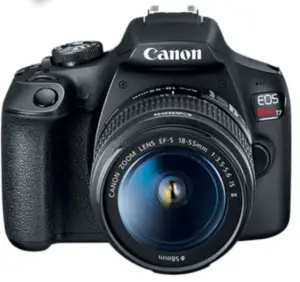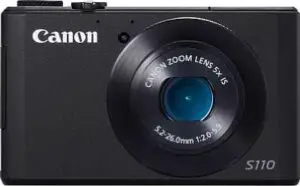Canon Rebel T100 (EOS 4000D) vs Rebel T7 (EOS 2000D) Comparison 2021 Updated
Entry level DSLRs Canon Rebel T7 (EOS 2000D) and Rebel T100 (EOS 4000D) Compared
Surely nobody missed this, but Canon still brings back the plastic bayonet with the Rebel T100 (EOS 4000D). [Photo: Canon]
The Canon Rebel T7 (EOS 2000D), on the other hand, uses a more robust metal bayonet, and the image sensor also has a higher resolution of 24 megapixels than both the Rebel T100 (EOS 4000D) and its predecessor, the Canon Rebel T6 (Canon EOS 1300D elsewhere), which both have to make do with 18 megapixels. [Photo: Canon]

In the comparison updated in 2022 of the Canon 2000d vs 400d model, we can define the difference between them as follows:
Whereas the 2000d and the 4000d have the same size of sensor, the 2000D delivers a higher resolution of 24 mpx while the 4000D only 17.9 mpx. Furthermore, the 2000D has a range of sensitivity of ISO 100-6400. Likewise, the on-board flash has to be folded up manually on the Rebel T100 (EOS 4000D), while the Rebel T7 (EOS 2000D) has an automatic and a button to fold it out.
While the Rebel T7 (EOS 2000D) with the EF-S 18-55 mm F3.5-5.6 IS II should cost almost 500 dollars while the Rebel T100 (EOS 4000D) together with the EF-S 18-55 F3.5-5.6 III (without IS) should be available for almost 400 dollars.
Furthermore, printed buttons have fallen victim to the austerity dictates, and there is also no longer a dedicated on/off switch; instead, the camera is switched on via the program dial. Even with a set lens, savings are made; it has to get by without an optical image stabilizer. Canon has even made considerable savings on the rear screen: it measures just 6.8 centimeters diagonally on the Rebel T100 (EOS 4000D) and has a resolution of a measly 230,000 pixels. After all, the Rebel T7 (EOS 2000D) uses a 7.5-centimeter screen with a resolution of 920,000 pixels.

Save on the back of the Canon Rebel T100 (EOS 4000D): The screen is 6.8 centimeters small and the buttons are not printed, instead, the functions are on the housing. [Photo: Canon]

The Canon Rebel T7 (EOS 2000D) has a larger 7.5 cm screen and has printed buttons. [Photo: Canon]
The Rebel T7 (EOS 2000D) at least gets an image sensor with 24 megapixels higher resolution in APS-C format (crop factor 1.6), while the Rebel T100 (EOS 4000D) has to get along with 18 megapixels like the old Canon Rebel T6 (Canon EOS 1300D elsewhere).
The maximum sensitivity reaches ISO 6,400, an extension to ISO 12,800 is possible after activation in the menu. The Digic 4+ image processor is also an old acquaintance, already driving the Canon Rebel T6 (Canon EOS 1300D elsewhere).
The reflex viewfinder of both cameras has to make do with a simple mirror construction instead of a high-quality pentaprism. At 0.8x magnification (0.5x in 35 mm equivalent), it covers 95 percent of the image field. The autofocus works in viewfinder mode with nine measuring points, only the middle autofocus point is a cross sensor. The continuous-advance mode only takes three frames per second.

Even on the upper side, the Canon Rebel T100 (EOS 4000D) has a budget dictate: the camera is switched on and off via the program dial instead of via a separate switch. [Photo: Canon]

The Canon Rebel T7 (EOS 2000D), on the other hand, has a proper switch for switching on and off. This way the program selector wheel remains in the last used position. [Photo: Canon]
Even with the video function, the entry-level photographer has to be satisfied with Full HD standard fare (1,920 by 1,080 pixels at 30 frames per second). During live viewing and video recording, only a contrast autofocus is available, while the faster dual-pixel CMOS AF is reserved for higher-quality EOS models.
Both the Rebel T7 (EOS 2000D) and Rebel T100 (EOS 4000D) detect subjects automatically, but can also be controlled manually by the photographer. They also offer some creative filter functions. WLAN is also on board in both models to transfer photos wirelessly to computers, smartphones, or other devices and to control the cameras remotely via an app.
NFC for simple coupling, however, is only offered by the Rebel T7 (EOS 2000D). Both the cameras themselves and the Canon Photo Companion app provide helpful instructions on how to take various photo subjects.

The Canon Rebel T100 (EOS 4000D) is available in a set with the EF-S 18-55 mm F3.5-5.6 III for just under 400 dollars. [Photo: Canon]

The Canon Rebel T7 (EOS 2000D) is available in a set with the EF-S 18-55 mm F3.5-5.6 IS II for just under 500 dollars. [Photo: Canon]
One important thing buyers of the Rebel T7 (EOS 2000D) and Rebel T100 (EOS 4000D) should still keep in mind: Although they are fully compatible with the many EF and EF-S lenses, Canon alone offers more than 80 different models, the flash shoes no longer have center contacts.
The Speedlite flashes from Canon don’t mind this, but to what extent third-party flashes are affected can’t be said at the moment. Simple center contact flashes logically do not work anyway.
The Rebel T7 (EOS 2000D) and Rebel T100 (EOS 4000D) differ in one small additional point when it comes to the flash: the on-board flash has to be folded up manually on the Rebel T100 (EOS 4000D), while the Rebel T7 (EOS 2000D) has an automatic and a button to fold it out.
The Canon Rebel T7 (EOS 2000D) and Rebel T100 (EOS 4000D) are available since 2018, whereas the Rebel T7 (EOS 2000D) with the EF-S 18-55 mm F3.5-5.6 IS II should cost almost 500 dollars while the Rebel T100 (EOS 4000D) together with the EF-S 18-55 F3.5-5.6 III (without IS) should be available for almost 400 dollars.
The predecessor model Canon Rebel T6 (Canon EOS 1300D elsewhere), however, is already available with an image-stabilized lens for a good 370 dollars, so that we can’t recommend the worse equipped and more expensive Rebel T100 (EOS 4000D) to anyone with a clear conscience at the moment. The Rebel T7 (EOS 2000D) offers a higher sensor resolution after all.


